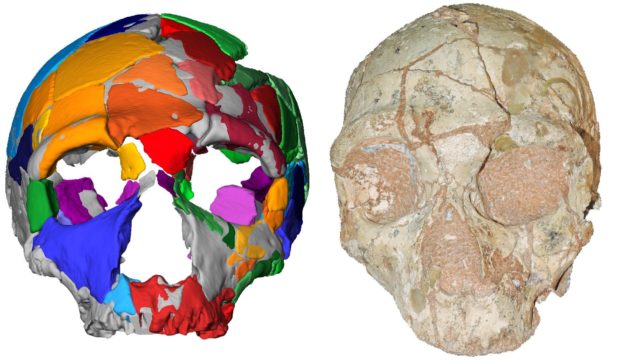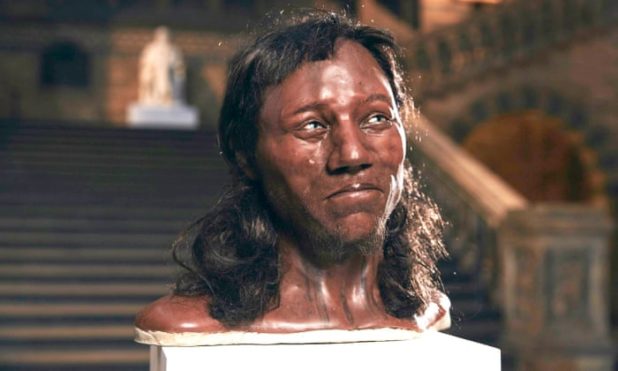Andrew Anglin
Daily Stormer
July 11, 2019
This week the media casually reported, without any fanfare – or didn’t bother to report at all – the fact that a paper was published reclassifying a skull discovered in Greece in the 1970s as that of a Homo sapiens, which puts back modern man’s arrival on the European continent very significantly.
A 210,000-year-old skull has been identified as the earliest modern human remains found outside Africa, putting the clock back on mankind’s arrival in Europe by more than 150,000 years, researchers said Wednesday.
In a startling discovery that changes our understanding of how modern man populated Eurasia, the findings support the idea that Homo sapiens made several, sometimes unsuccessful migrations from Africa over tens of thousands of years.
Southeast Europe has long been considered a major transport corridor for modern humans from Africa. But until now the earliest evidence of Homo sapiens on the continent dated back only around 50,000 years.
There has however been a number of discoveries indicating the ancient presence of Neanderthals—an early human cousin—across the continent.
Two fossilised but badly damaged skulls unearthed in a Greek cave in the 1970s were identified as Neanderthal at the time.
In findings presented in the journal Nature, an international team of researchers used state-of-the art computer modelling and uranium dating to re-examine the two skulls.
One of them, named Apidima 2 after the cave in which the pair were found, proved to be 170,000 years old and did indeed belong to a Neanderthal.
But, to the shock of scientists, the skull named Apidima 1 pre-dated Apidima 2 by as much as 40,000 years, and was determined to be that of a Homo sapiens.
That makes the skull by far the oldest modern human remains ever discovered on the continent, and older than any known Homo sapiens specimen outside of Africa.
“It shows that the early dispersal of Homo sapiens out of Africa not only occurred earlier, before 200,000 years ago, but also reached further geographically, all the way to Europe,” Katerina Harvati, a palaeoanthropologist at the Eberhard Karls University of Tuebingen, Germany, told AFP.
The Apidima 1 partial cranium (right) and its reconstruction from posterior view (middle) and side view (left). The rounded shape of the Apidima 1 cranium a unique feature of modern humans and contrasts sharply with Neanderthals and their ancestors. Credit: Copyright Katerina Harvati, Eberhard Karls University of Tübingen.
“This is something that we did not suspect before, and which has implications for the population movements of these ancient groups.”
Apidima 1 lacked classic features associated with Neanderthal skulls, including the distinctive bulge at the back of the head, shaped like hair tied in a bun.
We are constantly told that “everyone came from Africa,” and this has even been used by ostensibly serious people to justify mass immigration of blacks from Africa into Europe.
We all remember too well that just last year, it was a very big deal when some political activists claiming to be scientists released a bust – called a “reconstruction” – of a 10,000-year-old human from Britain – the Cheddar Man – showing him with black skin.
People went absolutely nuts, saying that this statue proved that black Africans belonged in Britain.
The “Black British” man Gary Younge, who had recently had an awkward confrontation with Richard Spencer, during which confrontation Richard informed Gary that he is “not British,” tweeted the implication that this statue meant he really was a True British human.
Suck on that Richard Spencer https://t.co/zomnyKYjkT
— Gary Younge (@garyyounge) February 7, 2018
Very quickly, people began assessing the data used to determine the nature of this statue and the Yeti-Hunter who built it.
The team that built it was forced to admit that they actually had no idea what color Cheddar Man’s skin was.
The media dropped the story.
No retractions were issued to my knowledge, but the Wikipedia entry was edited in a quite embarrassing manner:
Analysis of his nuclear DNA indicates that he was a typical member of the western European population at the time, probably with lactose intolerance, blue eyes, and dark curly or wavy hair and, less certainly, dark skin.
From that bizarre spectacle, we can say definitively that archaeology is used for political purposes aggressively when it fits an agenda.
And I would argue that the lack of any serious front-page coverage of this recent Nature article showing that modern man was in Europe a complete 150,000 years before we’d previously been told is equally political.
If this study is accurate, it is an extremely major thing. It would change the basic natural history that is taught in elementary school.
The “Out of Africa” theory is what is taught as universally-accepted science, and it is taught for a clear political purpose: it backs up the Jewish lie that “we are all one race – the human race.”
Before the Out of Africa theory became official state dogma in the West, serious people would openly discuss the idea that the different races evolved from different species of ape. The obvious political problems with that make it clear why that theory is no longer considered acceptable.
Setting back the presence of modern humans in Europe 150,000 years does not disprove the Out of Africa theory, but it certainly weakens it significantly.
A 2017 study which was also buried by the media forwarded the idea that modern humans developed in Europe, and moved South. This would fit in with Julius Evola’s theory that godlike beings once inhabited a continent called Hyperborea on the North Pole, and devolved as they moved south – and throwing that piece of information in here might seem silly, but it actually isn’t, really. We in fact have no idea what the ancient history of man is, and yet we are constantly told by the media and academia that it’s all pretty much settled.
I personally am not at all convinced by the entire theory of evolution. I do not identify as a “creationist,” which is a slur, but from what I am able to gather, there is no solid proof for really any of the claims made by the modern scientific establishment with regards to the origin of humans.
The problems become much more obvious when you look at the fact that they have literally no explanation whatsoever for the origin of life itself. I think we can all follow along with the theory of evolution on some level, but the idea that life created itself accidentally in a “primordial soup” is absolute lunacy, and cannot be considered to be a serious scientific theory by any serious person.
The truth of reality is that it is easier to believe a literalist interpretation of the Book of Genesis or the Cthulhu Mythos than this spontaneous living soup gibberish.
Ultimately, the origin of life and the origin of consciousness are things that can only be explained through metaphysics. I’m not ashamed to say that. And the sooner we’re all able to say that plainly, without fear of being shamed, the closer we are going to be to finding a solution to our troubles.
Gigantic cracks emerging within the establishment claims with regards to the origins of man open up possibilities, and can and must lead to a reexamination of core beliefs about the nature of humanity, the nature of consciousness and the nature of existence itself.
I believe – or rather, I know, but for the sake of objectiveness, we should say “I believe” – that matter is a creation of consciousness and that consciousness is a fragment of the being of God and that God always existed.
In the beginning was the Word, and the Word was with God, and the Word was God.
https://www.youtube.com/watch?v=ZF4Z6smOrZw






